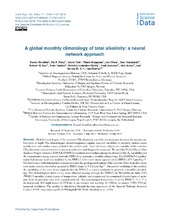| dc.contributor.author | Broullón, Daniel | |
| dc.contributor.author | Perez, F. F. | |
| dc.contributor.author | Velo, Antón | |
| dc.contributor.author | Hoppema, Mario | |
| dc.contributor.author | Olsen, Are Christian Sviggum | |
| dc.contributor.author | Takahashi, Taro | |
| dc.contributor.author | Key, Robert M. | |
| dc.contributor.author | Tanhua, Toste | |
| dc.contributor.author | Gonzales-Davila, Melchor | |
| dc.contributor.author | Jeansson, Emil | |
| dc.contributor.author | Kozyr, Alexander | |
| dc.contributor.author | van Heuven, Steven | |
| dc.date.accessioned | 2020-04-11T10:40:50Z | |
| dc.date.available | 2020-04-11T10:40:50Z | |
| dc.date.issued | 2019-07-31 | |
| dc.Published | Broullón, Perez, Velo, Hoppema, Olsen, Takahashi, Key, Tanhua, Gonzales-Davila, Jeansson, Kozyr, van Heuven. A global monthly climatology of total alkalinity: A neural network approach. Earth System Science Data. 2019;11:1109-1127 | eng |
| dc.identifier.issn | 1866-3516 | en_US |
| dc.identifier.issn | 1866-3508 | en_US |
| dc.identifier.uri | https://hdl.handle.net/1956/21838 | |
| dc.description.abstract | Global climatologies of the seawater CO2 chemistry variables are necessary to assess the marine carbon cycle in depth. The climatologies should adequately capture seasonal variability to properly address ocean acidification and similar issues related to the carbon cycle. Total alkalinity (AT) is one variable of the seawater CO2 chemistry system involved in ocean acidification and frequently measured. We used the Global Ocean Data Analysis Project version 2.2019 (GLODAPv2) to extract relationships among the drivers of the AT variability and AT concentration using a neural network (NNGv2) to generate a monthly climatology. The GLODAPv2 quality-controlled dataset used was modeled by the NNGv2 with a root-mean-squared error (RMSE) of 5.3 µmol kg−1. Validation tests with independent datasets revealed the good generalization of the network. Data from five ocean time-series stations showed an acceptable RMSE range of 3–6.2 µmol kg−1. Successful modeling of the monthly AT variability in the time series suggests that the NNGv2 is a good candidate to generate a monthly climatology. The climatological fields of AT were obtained passing through the NNGv2 the World Ocean Atlas 2013 (WOA13) monthly climatologies of temperature, salinity, and oxygen and the computed climatologies of nutrients from the previous ones with a neural network. The spatiotemporal resolution is set by WOA13: 1∘ × 1∘ in the horizontal, 102 depth levels (0–5500 m) in the vertical and monthly (0–1500 m) to annual (1550–5500 m) temporal resolution. The product is distributed through the data repository of the Spanish National Research Council (CSIC; https://doi.org/10.20350/digitalCSIC/8644, Broullón et al., 2019). | en_US |
| dc.language.iso | eng | eng |
| dc.publisher | Copernicus Publications | en_US |
| dc.rights | Attribution CC BY | eng |
| dc.rights.uri | http://creativecommons.org/licenses/by/4.0/ | eng |
| dc.title | A global monthly climatology of total alkalinity: A neural network approach | en_US |
| dc.type | Peer reviewed | |
| dc.type | Journal article | |
| dc.date.updated | 2020-02-10T14:50:51Z | |
| dc.description.version | publishedVersion | en_US |
| dc.rights.holder | Copyright 2019 The Author(s) | en_US |
| dc.identifier.doi | https://doi.org/10.5194/essd-11-1109-2019 | |
| dc.identifier.cristin | 1772018 | |
| dc.source.journal | Earth System Science Data | |
| dc.relation.project | EC/H2020: 633211 Atlantos | |

